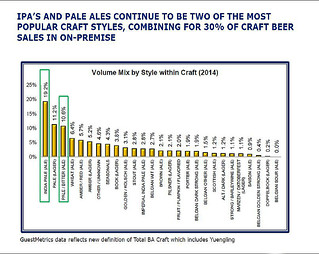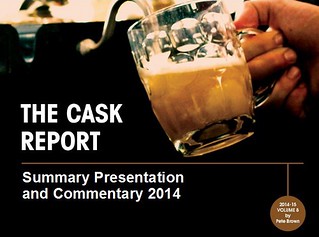A friend recently tweeted me that she was unable to access a story that I had linked on Twitter from its original spot on Facebook. She posts to Twitter, but not to Facebook. Strange new social-media world!
Yours For Good Fermentables has its own Facebook page (of the same name). That isn't big news, but it is important to me because I maintain both. As it happens, I occasionally neglect the blog because of Facebook's quick-and-easy, brief-and-breezy posting (as if writing out three-hundred words at the blog had become a hardship). Last week, I wrote only once at the blog, but posted what amounted to twice a day at the Facebook (is 'the' correct?).
Here's the story she couldn't see:
Craft?
"Whole grain corn, sugar, marshmallows (sugar, modified corn starch, corn syrup, dextrose, gelatin, red 40, yellows 5&6, blue 1, natural and artificial flavor), corn meal, canola and/or rice bran oil, corn syrup, corn starch, cocoa processed with alkali, modified corn starch, salt, tricalcium phosphate, caramel and beet juice concentrate for color, trisodium phosphate, natural and artificial flavor, red 40, yellow 5&6, blue 1, wheat flour, peanut flour, vitamin E (mixed tocopherols) and BHT added to preserve freshness."
The ingredient list of a mainstream beer? No! Big breweries don't use those items in their beers (well, okay, maybe they do use some of them, such as gelatin, dextrose, corn syrup, caramel coloring, and natural and artificial flavoring).
But a 'craft' brewery? It would never, ever, use such ingredients, would it?
"Yeah, we added them to our beer," crowed the bartender at the taproom of a local 'craft' brewery, proudly describing to me how the brewery had tossed Count Chocula cereal into its cask ale.
General Mills beer. Not 'Kraft' beer. No, thanks.
***************
Here are a few more:
- The FDA to require chain-restaurants (with 20 or more locations) to display nutritional information for beer, wine, cider on their menus, by Dec. 1, 2016. Could be difficult for smaller breweries (wineries and cideries) to supply that information. In light of the FDA ruling, it's interesting to recall that, in 1992, 'craft' beer pioneer (and curmudgeon) Bert Grant did put nutritional information on the label of his Grant's Scottish Ale ... but, back then, the U.S. government told him to cease and desist.
- Balance and not balance in beer.
The idea of moderation in brewing is not the idea of capitulation, of surrender, of turning your back on the way forward. It's a way of seeking silence in between the gaps that modern life manages to create - it's a polite cough, a feather stroke on the inner thigh, a reflective passage from an étude by Chopin, the intermission between nothing and I love you. And sometimes we need beers like that in the way we also need beers that cackle and burn like a martyr's bonfire or ululate across the night air like a trident in its tracks or even leave us unsure of what we're tasting. Like an Earth on its axis beer also needs balance.—Adrian Tierney-Jones, at Called to the Bar.
- The number one 'craft' beer style on tap in the U.S.? No surprise: IPA (India Pale Ale), with a 19.2% share.
2. Pale Lager: 11.2%.
3. Pale Ale: 10.6%. - Cask sales are growing in the U.K., but, in the U.S., we don't maintain those data.
According to the UK Cask Report, cask sales grew 1.3% in 2014, outperforming pub keg and bottle sales growth by 4.5%. UK cask sales in 2014 accounted for 8.2% of the total beer market and 16.1% of all on-trade (restaurants, pubs). Cask is 58.6% of the "draught" market, while kegged beer is 41.4%. This represents a reversal of share since 2006, when these same figures were the other way round.
In the U.S., the Brewers Association does not recognize cask ale as a category or production method, at least at its annual competition, the Great American Beer Festival. It publishes no accurate figures for U.S. cask-ale sales.
- Forget the controversy at the Vatican's Synod on the Family. The real scandal was that the Archbishop of Cologne admitted that he prefered Dusseldorf's rival Altbier to Cologne's native Kölsch.
- "Hops can take 10 to 12 years to develop before they’re marketed to breweries." Nicholas Gingold in All About Beer, a good long read, with lovely photos: "In Search of America's Best Hops."
- Ahead of its (and his) time: twenty-five years ago, the Discovery Channel aired Michael Jackson's "The Beer Hunter."
“My name really is Michael Jackson, but I don’t sing and I don’t drink Pepsi. I drink beer.”—Tom Acitelli in All About Beer. 27 October 2015.
“Why should wine drinkers be esteemed as nobs while beer drinkers are put down as slobs?,” the New York Times TV critic Walter Goodman asked his readers.
Jackson’s show was an unprecedented effort “to correct this injustice and get equal treatment for those who prefer the mix of the malt to the fruit of the vine.”
- I do post a wrap-up of beer stories (and other things), once every other week. Things that I observed but didn't necessarily blog about but may have tweeted or 'Facebooked.' I call it Clamps and Gaskets.
- For more from YFGF:
- Follow on Twitter: @Cizauskas.
- Like on Facebook: YoursForGoodFermentables.
- Follow on Flickr: Cizauskas.
- Follow on Instagram: @tcizauskas.












Great post! You’ve explained it so clearly. We actually touched on a related idea on our site too—nice to see the alignment!facebook
ReplyDelete